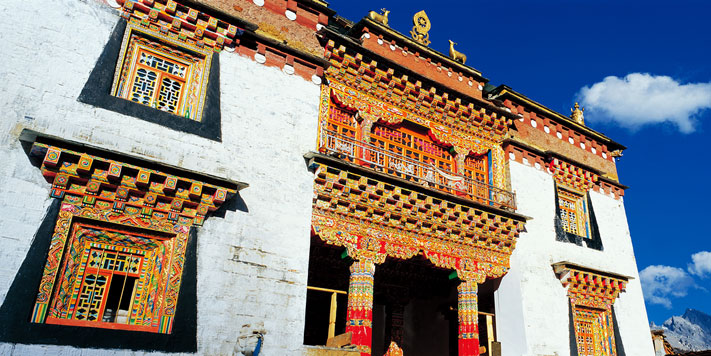Sichuan Overview

The province of Sichuan lies in southwest China and is one of the country’s major industrial bases. The territory of the province and its vicinity were the cradle of unique local civilizations, which can be dated to at least 15th century BC.
The area lies in the Sichuan basin and is surrounded by the Himalaya to the west, Qinling range to the north, and mountainous areas of Yunnan to the south. The Yangtze River flows through the basin and thus is upstream to areas of eastern China. The Minjiang River in central Sichuan is a tributary of the upper Yangtze River, which it joins at Yibin.
The majority of population is Han Chinese, who are found scattered throughout the province. Significant minorities of Tibetans, Yi, Qiang and Naxi reside in the western portion, which was a part of historic Tibet's Kham region.
Kham Overview

Located at the edge of the southeast Qinghai-Tibet Plateau, Kham in the southeast encompasses parts of western Sichuan, northern Yunnan, southern Qinghai and a few part of eastern Tibet TAR. This wide area is generally called Kham Tibetan region, and western Sichuan is the main part of Kham.
Kham Tibetan region is situated at the transition zone of Qinghai - Tibet Plateau and Sichuan Basin that is very different from the dry and brown Tibetan plateau. It has a complete climate spectrum and a complex topography, which forms the particular sceneries of mountainous, lakes, glaciers, rivers, biology and climates. There are simple, unspoiled but colorful Tibetan cultures, and many Tibetan Buddhism monasteries.
Geography

Sichuan Province, known as Chuan or Shu for short name, is located in the southwestern part of China, bordering Chongqing to the east, Tibet TAR to the west, Qinghai and Gansu to the north, Yunnan and Guizhou to the south. Sichuan has a total area of 485,000 square kilometres and population of 87 million. Sichuan is one of the largest provinces in China.
Geographically speaking, Sichuan could be roughly divided into two completely different parts along the meridian of longitude 130 °. The east part is Sichuan Basin, where is low for the terrain, scattered with the hills, mounds and mountains. The west is the plateau, the average altitude is more than 3,000 meters. It is the world for high snow mountains, glaciers, swamps and grasslands. Rivers in Sichuan belong to two major water systems, the Yellow River and the Changjiang River, and the drainage area is 3% of the province’s entire area.
Climate

Due to the great different terrain and the various seasonal winds, the climate of the Sichuan is highly variable in the east basin and west Sichuan highland. The Sichuan Basin in the eastern half of the province experiences the humid subtropical monsoon climate, and it has four distinct seasons with hot, humid summers, and moist and cloudy winters, and China's lowest sunshine totals. The western mountainous areas have a cooler but sunnier climate, with cool to very cold winters and mild summers. The region is geologically active with landslides and earthquakes. The southern part of the province, including Panzhihua and Xichang, has a sunny climate with short, very mild winters and very warm to hot summers.
History

Sichuan Province is known as Chuan or Shu for short name, because the unique and highly developed Ba Shu civilizations arise here dating back to at least 15th century BC and coinciding with the Shang and Zhou dynasties in north China. During this Bronze Age, two rival kingdoms, the Shu and the Ba Kingdoms were established. Two archaeological sites concerning the Shu civilization were unearthed in 1987 and 2001, represented respectively by Sanxingdui and Jinsha.
Following by 316 BC, the Kingdoms of Shu and Ba were conquered by the Qin dynast, and it then became two jun (prefectures) of the large empire. It was during this dynasty that the Dujiangyan irrigation and flood control system was built that improved agricultural technology for intensive farming in Chengdu plains. The regime was replaced later by the Three Kingdoms after the Han dynasty was divided into three warring empires. Chengdu was the capital of the short-lived Shu Kingdom of Emperor Liu Bei (161-223) and his renowned minister Zhuge Liang (181-234). Wuhou Temple in Chengdu was built for commemorating them. Sichuan blossomed under the Tang, when the province produced Wu Zetian, the country’s only empress, and numerous famous scholars and poets. Prosperity continued through the subsequent Song dynasty, when the world’s first paper money was printed in Chengdu in 1024.
Today, Chongqing as the region of ancient Ba Kingdom has been sheared off from Sichuan, the ancient Shu Kingdom, as the China’s fourth municipality in 1997, Sichuan is still a major beneficiary of the ongoing Go West campaign of China, which encourages Chinese industry from the wealthy eastern provinces to relocate inland.
Sichuan Cuisine
Sichuan cuisine, is very famous as one of the eight traditional Chinese cuisines. The cuisine here is featured on being spicy and numbing heat, with the advanced skills of making sources that are the ingredients with Sichuan peppercorn, chilli, ginger, spicy herbs and broad bean chilli paste for various flavors. Sichuan cuisine has major four styles by location: Chengdu, Chongqing, the Yangtze and Jialing River. So the flavor includes Chongqing, Chengdu, Leshan, Neijiang, Zigong and other local style dishes' characteristics. The representative local food include Kung Pao Chicken, Twice Cooked Pork, Mapo Tofu (Stir-Fried Tofu in Hot Sauce), and extremely spicy hot pot.

